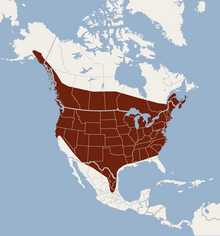Silver haired bat
| Silver haired bat | ||||||||||||
|---|---|---|---|---|---|---|---|---|---|---|---|---|

Silver haired bat ( Lasionycteris noctivagans ) |
||||||||||||
| Systematics | ||||||||||||
|
||||||||||||
| Scientific name of the genus | ||||||||||||
| Lasionycteris | ||||||||||||
| Peters , 1865 | ||||||||||||
| Scientific name of the species | ||||||||||||
| Lasionycteris noctivagans | ||||||||||||
| ( LeConte , 1831) |
The silver- haired bat ( Lasionycteris noctivagans ) is a bat from the smooth-nosed family (Vespertilionidae) that is native to North America. The genus Lasionycteris is monotypical , which means that besides Lasionycteris noctivagans no other species of the genus is known.
The generic name Lasionycteris is made up of the Greek "lasio" (= hairy) and "nycteris" (= bat). The species name noctivagans combines the two Latin words "noctis" (= night) and "vagans" (= wandering).
description
The silver-haired bat is a species of bat with dark fur and characteristic silver-white hair tips, which makes this species unmistakable. Only in particularly old males can the tips be less rich in contrast and the fur more yellowish. Ears and flight skin are uniformly black. The total length of the silver haired bat is 92–115 mm with an average weight of 8.1 to 11 g.
Way of life
The silver-haired bat , like most bats, is nocturnal and feeds on insects, catching moths , beetles , two-winged bats and caddis flies relatively opportunistically . The species flies out of its roosts comparatively late and has its main activity time 2–4 hours and 6–8 hours after sunset. Otherwise, little is known about their behavior and ecology. The silver haired bat probably spends the day in crevices and hollow trees. As with many other bat species in temperate latitudes, mating takes place in autumn. The females store the sperm in their sexual organs through the winter. The ovulation takes place in April and May, after which the egg is fertilized by the stored sperm. After a gestation period of 50 to 60 days, the females give birth to one or two naked, blind young animals. The young are suckled for 36 days after birth. The oldest silver-haired bat caught was 12 years old.
distribution
The silver-haired bat occurs from south-eastern Alaska through southern Canada and the United States to north-eastern Mexico and Bermuda . The IUCN has rated the species as harmless thanks to its widespread distribution and its occurrence in protected areas.
literature
- TH Kunz (1982): Lasionycteris noctivagans. In: Mammalian Species . No. 172, pp. 1-5.
